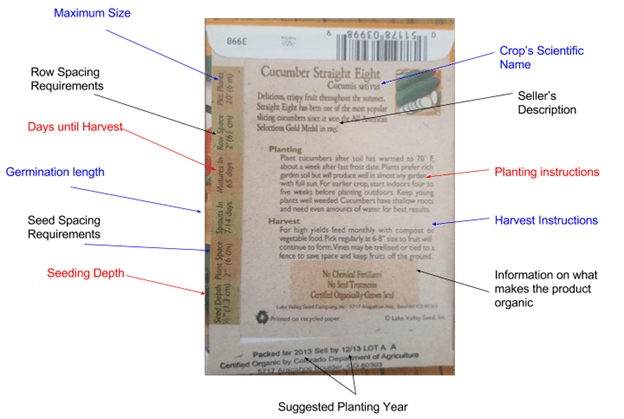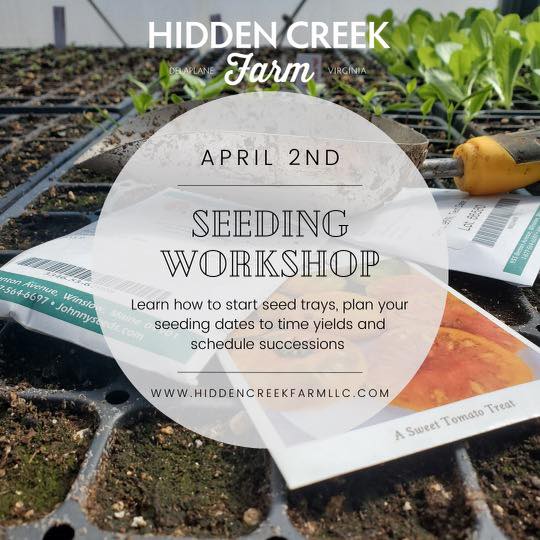Choosing varieties:
- What types of plants you want to grow (cucumbers, tomatoes, basil)
- What varieties of these plants do you want to grow?
- Variety influences flavor, color, and size (think tomatoes) and influences characteristics like temperature tolerance, drought tolerance, pest/disease resistance, and fruiting frequency
- VA has heat and cold, so the best varieties to plant will change with the seasons
- Not all plants should be started in trays!
- Root vegetables and other densely planted crops work better when direct seeded.
- See last page for notes about tomato, cucumber, and basil varieties
The seed packet is your best friend! All this information and more can be found on the seed packet. Any information not on the seed packet can be easily found in the seed catalog or on the seed company website. Keep your seed packets all season for easy reference.

Calculating Start Date:
- When do you want to harvest the crop? Work backwards from there.
- Stay within the appropriate harvest season
- Use the “days to maturity” listed on the seed packet. Is this from seed or from transplant?
- Some seed packets will specify the amount of time in the trays
- Stagger seeding dates to spread out the harvest.
Seeding in Trays (demonstration)
- What size tray should you use?
- Choose a good potting soil or mix your own with soil from your yard and compost or another source of nutrients and organic matter.
- Moisten the potting soil before filling trays
- The soil has ideal moisture content when you can squeeze the soil in your fist and some moisture appears between your fingers, but not enough to drip. The soil should hold its shape, but crumble easily.
- Pre-moistening the soil helps it better absorb water later. Dry soil will absorb water unevenly and cause most water to runoff or through the soil.
- Fill the trays with soil by gently spreading it across the top and tapping the tray to gently pack it down.
- Make holes for the seeds with your fingers
- Seeding depth is indicated on the back of the seeding packet
- Drop 1-3 seeds in each hole.
- Seeding density depends on the crop and is listed on the back of the seeding packet
- Extra plants can be thinned or separated and replanted when the seeds germinate
- Cover the seeds with soil, tap the tray gently to pack down, water in to compact
Caring for Your Seedlings:
- Find a sunny spot, like a south facing window, or invest in full spectrum fluorescent lights
- A sign of too little sunlight is “leggy” seedlings with long, weak stems. This makes seedlings fragile and difficult to transplant.
- Keep your seedlings at 60˚F-75˚F
- Peppers at tomatoes prefer warmer soil temperatures to germinate (at least 55˚F) and lettuces prefer cooler soil temperatures.
- If germination is a problem, consider adjusting the temperature with a heated seedling mat.
- Do your seedlings need a bigger tray?
- Seedlings that spend longer in trays benefit from being “potted up” into larger trays as they develop.
- This gives the seedlings access to more nutrients and limits they likelihood they will become root bound.
- Root bound is when the roots become so dense and intertwined that the soil stays in a dense block. This limits pores for oxygen and water and makes it more difficult for roots to expand into new soil when they are transplanted.
Transplanting:
- Harden off the plants by placing them outside a few days before you want to transplant.
- This will get the seedlings used to cooler/warmer weather and wind, making them better able to handle the stress of transplanting.
- Determine your spacing.
- Recommended spacing is listed on seeding packets.
- The space between plants affects air flow (important for moisture and disease control), plant size, and number of plants.
- Dig holes deep enough to cover the transplant with soil level with (or just above) the transplant soil.
Varieties:
Tomato Varieties –
- Heavy feeders, need fertile soil
Determinate vs. Indeterminate
- Determinate
- ripen early and in distinguishable flushes
- ideal for canning a lot at once
- 3-4’ tall, “bush” tomato plants
- less to no pruning and trellising required
- stop shoot production once flowers form on shoot ends
- smaller, more appropriate for container growing
- ripen early and in distinguishable flushes
- Indeterminate
- longer growth period, can produce consistent fruit until frost arrives
- 6-20’ tall
- form flowers along sides of shoot and continue to grow
- benefit from pruning and trellising
- most heirloom varieties are indeterminate
Cucumber Varieties –
- Heavy feeders, need fertile soil
- Benefit from warm, moist soil
- steady supply of moisture
- consider mulching to conserve moisture and heat
Vining vs. “Bush” Cucumbers
- Vining
- Sprawling or trellised
- Many varieties
- “Bush”
- Less space, ideal for container planting
- fewer varieties
Basil Varieties –
- Four basic types: sweet basils, small-leaved/dwarf basils. purple-leaved basils, and basils with specially scented leaves (lime, chocolate, cinnamon, etc.)
- Different varieties can cross pollinate, consider when planting near each other
- Avoid temperatures below 50˚F, prefers 60-80˚F
- Consistent moisture
- Pinch flowering tops to encourage continued leaf production.

